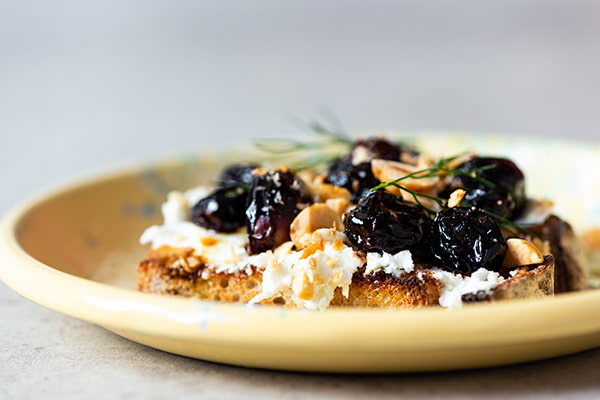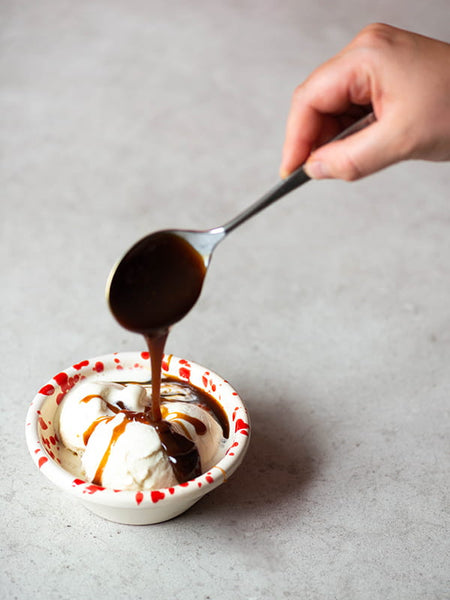
How To Use Balsamic Vinegar... When It Isn't In A Salad Dressing
By Giovanna Ryan
-
Easy

Type “balsamic vinegar recipes” into Google and you'll be greeted with a vast number of vinaigrette and salad dressing recipes. However, these little bottles of mysterious, dark liquid have so much more to offer than coating a bowl of leaves.
Read on to see Giovanna Ryan share her favourite balsamic vinegar recipes... when they're not in a salad!
To learn more about how to choose the best balsamic vinegar, read our buyers' guide. Alternatively go direct to shop for the best balsamic vinegar.
Which balsamic vinegar should I use?
Balsamic vinegar originates from Modena and the surrounding region of Reggio Emilia.
Unlike other vinegars, true balsamic vinegar is not made from wine but from the Trebbiano grape and is aged in a series of barrels.
It is a serious and highly laborious art and results in the most extraordinary but expensive of balsamic vinegars. Italians consider Balsamico Tradizionale to be a highly precious product and, due to its price tag, is used sparingly and on special occasions.
There are, however, cheaper alternatives if you’re looking for a more everyday product to use in cooking to enhance the flavour of a particular ingredient or to add depth to a dish.
For more information on choosing a balsamic vinegar, take a look at the Sous Chef guide to choosing the best balsamic vinegar.
How can I use balsamic vinegar?
A good, true balsamic vinegar should be used sparingly and simply. For these ideas we recommend balsamics aged 12 years+.
- Its sweetness and acidity is an excellent way to enhance ingredients that are already sweet and acidic, such as tomatoes or to offset fatty, salty foods, such as cheese.
- A super simple way to enjoy high-quality balsamic vinegar is to drizzle it over a slice of parmesan as a snack or as part of an antipasti plate.
- Alternatively, finish a parmesan risotto with a few drops to cut through its creamy richness.
- Strawberries are widely acknowledged to be improved with a sprinkling of sugar and a splash of balsamic vinegar. When left for an hour or so to macerate, it encourages the fruit to soften slightly and creates the most wonderful syrup at the bottom of the bowl.
Less expensive versions of balsamic vinegar (8 years aged and less) can be used to great effect in a wide variety of dishes.
- Adding a few drops to tomato-based pasta sauces intensifies the acidic sweetness naturally found in tomatoes and will deepen the flavour of your sauce.
- Fattier meat dishes can be greatly enhanced by a couple of tablespoons of balsamic.
- Add to the braising liquid when slow cooking short ribs or lamb shanks or use to create a glaze on chicken thighs or duck roasted with fruit such as figs or plums.
- The humble roast potato can also be given a boost by adding a few tablespoons of balsamic vinegar halfway through roasting, the end result reminiscent of the best salt and vinegar crisps.
Three balsamic vinegar recipes you might not have thought to make
1. Balsamic roasted grape and goats cheese crostini
2. Balsamic caramel sauce
3. Balsamic negroni
Balsamic roasted grape and goats cheese crostini
Roasting grapes in balsamic vinegar brings out a wonderful almost raisin-like sweetness which is excellent paired with salty, zesty goats-cheese. Use an everyday balsamic (aged 8 years or less) to roast the grapes and a more luxurious 12+ year vinegar to finish if you have one.
Serves 4-6 people as a generous starter.

Ingredients for the Crostini
- Small sourdough loaf
- 500g black grapes
- 4 tablespoons balsamic vinegar (less than 8 years for a greater level of acidity)
- 300g soft goat’s cheese
- Large handful of hazelnuts, roughly chopped
- Flaky sea salt
To serve
- Dill fronds
- Good balsamic
- Good olive oil
How to Make the Crostini
- Preheat the oven to 190°C. Place the grapes on a baking tray and drizzle with the balsamic vinegar. Roast for around 20 minutes, turning occasionally, until the grapes are dark and sticky.
- Slice the sourdough and cut each slice in half. Place under a grill to toast, turning halfway, or pop in the toaster and keep warm
- Spread the soft goat’s cheese over the toasts. Add a few roasted grapes and some chopped hazelnuts and serve with a couple of dill fronds. Finish with a drizzle of good quality balsamic vinegar and a few drops of good olive oil.
Balsamic caramel sauce
Like adding salt to caramel sauce, adding balsamic vinegar offsets some of the sweetness of the caramel and creates a delightfully rich and complex sauce. It’s perfect generously spooned over good vanilla ice cream.
This makes a good amount to serve 6-8 people with ice cream.

Ingredients for the Caramel Sauce
- 120g caster sugar
- 75ml balsamic vinegar (less than 8 years old for a greater acidity)
- 50ml double cream
- Pinch sea salt
How to Make the Caramel Sauce
- Heat the sugar with a few splashes of water in a light coloured, heavy based saucepan until it reaches 148C on a sugar thermometer. If you don’t have one, heat until the sugar turns a dark amber colour. You need to watch it like a hawk as it can turn very quickly and don’t be tempted to stir the sugar otherwise it will crystallise.
- Add the balsamic vinegar to the caramel. It will spit and the sugar will harden but it will quickly turn back into a dark liquid. Continue to cook over a medium heat until you have a syrup that coats the back of a spoon.
- Add the double cream and cook for a few more minutes to thicken slightly. Finish with a pinch of salt.
- Serve generously over vanilla ice cream.
- The sauce will keep in the fridge, covered, for up to two weeks.
Balsamic Negroni
This version of a classic Italian negroni is inspired by a pickle negroni that I had in Lisbon. I was blown away by how the addition of pickling liquid lifted the cocktail. You only need half a tablespoon of balsamic in each serving so it’s worth using the good stuff here. Garnish with strawberries when they’re in season and a cornichon when they’re not.

Ingredients for one negroni
- 25ml red vermouth
- 25ml gin
- 25ml campari
- ½-1 tablespoon well-aged balsamic vinegar (12 years+)
- Orange peel, Strawberry or cornichon to serve
How to make the negroni
- Combine the vermouth, gin campari and balsamic vinegar in a glass filled with ice.
- Strain into a short glass with a large ice cube.
- Garnish and serve.

About the author
Giovanna Ryan was a Masterchef finalist in 2017 and is now a contributing food editor for House Beautiful UK. Born and raised in London, she comes from a family of foodies and is inspired by her Italian heritage. When she's not cooking up a storm in the kitchen she teaches classes for her business cook and feast.


